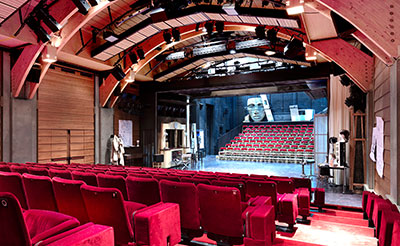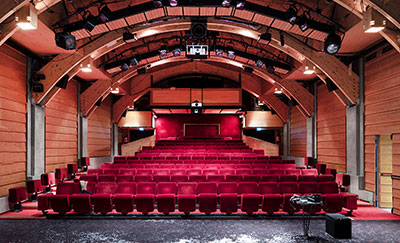Amadeus has completed the installation of a Holophonix sound processor and associated loudspeaker systems at the Théâtre du Vieux-Colombier, providing the venue with immersive sound.
 Located in the Saint-Germain-des-Prés district of Paris, the Théâtre du Vieux-Colombier hosts four productions each season, based on classical or contemporary texts. In 1993 the Théâtre du Vieux-Colombier became the second venue for the Comédie Française. Originally created in 1913 by Jacques Copeau, this major French cultural institution was founded in 1680 and hosted in the Palais-Royal’s Salle Richelieu since 1799. The theatre follows a ‘drama renovation’ concept in contrast to the Grand Boulevard theatres on Right Bank of the Seine.
Located in the Saint-Germain-des-Prés district of Paris, the Théâtre du Vieux-Colombier hosts four productions each season, based on classical or contemporary texts. In 1993 the Théâtre du Vieux-Colombier became the second venue for the Comédie Française. Originally created in 1913 by Jacques Copeau, this major French cultural institution was founded in 1680 and hosted in the Palais-Royal’s Salle Richelieu since 1799. The theatre follows a ‘drama renovation’ concept in contrast to the Grand Boulevard theatres on Right Bank of the Seine.
When Copeau left to lead a comedy theatre troupe in1924, the Vieux-Colombier was opened to avant-garde cinema and then jazz concerts. When threatened with closure, the theatre was acquired by the Government in 1986, becoming the second Comédie Française hall.
Accompanying an extensive renovation of its stage infrastructure, Théâtre du Vieux-Colombier electro-acoustical system has been redesigned in collaboration under the suervision of Technical Manager Philippe Lagrue and Dominique Bataille, a multidisciplinary creator, sound engineer and composer.
The system designed by Amadeus and Bataille is built around an Amadeus Holophonix spatial sound processor. Bataille was one of the system’s first users, operators and beta-testers of the processor, and was involved in the development of features essential to theatrical creation and ergonomics.
The main system is based on to a semi-spherical concept to get the best envelopment for spectators and adapted to the geometrical shape of the hall, and comprises 23 Amadeus speakers plus the Holophonix processor. Ten Amadeus PMX 8 MkII speakers (five on each side along the whole theatre floors’ depth) have been mounted in lateral ‘arches’ of a wooden frame reminiscent of a boat’s overturned hull. They are supplemented by eight PMX 5 MkIV speakers that are integrated into the upper arches. The LCR system is made of three new triaxial C15 speakers, co-developed with the Théâtre National de Chaillot. The sub-bass reinforcement system is built around two slim ABB 15 speakers, which were initially developed for the Théâtre des Abbesses (hence the ABB acronym).
 ‘Around 20 MPB 200 B speakers are sometimes used as a punctual sound source, onstage, in the flies or under the stage, according to projects and creations, enabling spatial illusions we love to imagine and to offer to the theatre audience. The speakers are actually declared as bus virtual outputs, and processed by the Holophonix processor using various spatialisation techniques,’ Bataille explains.
‘Around 20 MPB 200 B speakers are sometimes used as a punctual sound source, onstage, in the flies or under the stage, according to projects and creations, enabling spatial illusions we love to imagine and to offer to the theatre audience. The speakers are actually declared as bus virtual outputs, and processed by the Holophonix processor using various spatialisation techniques,’ Bataille explains.
The Holophonix processor allows sound designers to mix, reverberate and spatialise sound elements output from various devices using different spatialisation techniques, and to combine these techniques (or algorithms) in real time. The processor can handle a nearly limitless number of busses, each running an embedded algorithm, including Higher-Order Ambisonics (2D, 3D), Vector-Base Intensity Panning (2D, 3D), Vector-Base Amplitude Panning (2D, 3D), Wave Field Synthesis, Angular 2D, k-Nearest Neighbor, Stereo Panning, Stereo AB, Stereo XY, Native A-Format Ambisonics, Native-B Format Ambisonics and Binaural.
‘Over three years ago, Christian Hecq and Valérie Lesort had taken up the challenge to create Vingt Mille Lieues Sous les Mers (Twenty Thousand Leagues Under the Sea), an ‘all-audience’ spectacle involving actors and puppets. After a French tour last year, the show came back on the stage it was premiered on, the Théâtre du Vieux-Colombier,’ adds Bataille, the composer of the almost 90-minute long sound creation underlining the spectacle.
‘As the show returned to the Vieux-Colombier in 2018, we were able to re-work the original sound creation – originally completed with traditional techniques – adding elements and magnifying it with new “object-oriented” mixing and spatialisation tools. The various poly-algorithmic spatialisation techniques available in the Holophonix processor open an almost limitless creative field. We could thus make our own Ambisonic recordings and present them through Holophonix without any decoding, move several hundred sound elements in 2D or 3D, create an intriguing or oppressive sound space, a genuine trip to the deepest abyss, thanks to the included reverb settings.’
More: www.amadeuslab.com